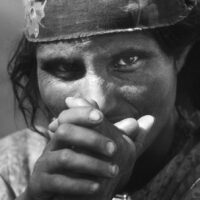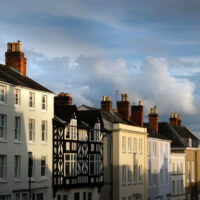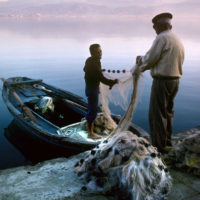Flash Powder
At the Advertiser, the photo-sales were printed by old Dougie. Way beyond the age of retirement, and certainly in his late seventies, Dougie was a formidable character; a former chief photographer on the newspaper, he had been kept on the payroll as a part-timer because, I suspect, nobody had the courage to tell him it was time he called it a day. He still liked to ‘keep his hand in’ by taking the occasional photograph for the newspaper, and insisted on being given an assignment from time to time.
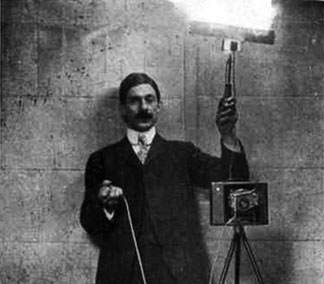
Developer and nicotine
Dougie was a robust, dapper, bow-tie sort of man. When he walked out in the town he sported a jaunty tyrolean hat with a brightly-coloured feather in the band. He often carried a cane with an ivory handle and a silver ring. He wore horn-rimmed spectacles whose lenses were permanently fogged around the edges with a sepia haze of nicotine from the cigarettes he chain-smoked.
Dougie’s fingers and fingernails were always deeply stained by oxidised print developer and nicotine. He was hardly ever seen without an un-tipped Capstan Full Strength cigarette stuck firmly to his bottom lip. Over the years, this lip had developed a colourless platform-like area of insensitive, fire-proof scar tissue due to its constant exposure to burning tobacco. Not until each cigarette had burned down to the last quarter of an inch or so would Dougie peel the burnt paper remnant from his lip and replace it with another cigarette. Sometimes he would tear a cigarette from his lip so that he could take great gulps of strong nut-brown tea from a chipped George VI coronation mug that might not have been rinsed for thirty years or more.
Talking face-to-face with Dougie was a nerve-racking business because he was always on the point of breaking into a smoker’s hacking cough. When this happened, the inch-long curl of ash at the end of his cigarette, which might have defied gravity and conversation for several minutes, would explode outwards like a blizzard.
Dougie used to enjoy showing off his prowess with an old-fashioned glass plate camera – the kind that needed the operator to judge the precise distance to each subject before setting this number on a brass scale beneath the lens. Like a Wild West gun-slinger, he would adjust the scale to an appropriate distance, then throw a cigarette packet into the air above his head. Before it could hit the ground, Dougie would wind up the camera’s focal-plane shutter and shoot the falling cigarette packet in mid-air. He would take on all comers and bet a shilling that his picture would be perfectly timed and pin-sharp when it was developed. It always was, and Dougie pocketed the money every time.
“Simple,” he would say, puffing out fag ash and smoke like a steam engine, “It’s nowt but a two-yarder at a 500th.”
Glass plates and bad smells
As befitted his seniority, Dougie had his own personal darkroom, and to enter this private domain was to take a step back into the age of pioneer wet-plate Victorian photography. The room was lined with dark shelves, and cupboards bursting with old plate cameras, black, woodwormed tripods and rusting flash powder trays.
He had no time for modern roll-films, especially 35mm, and referred to them as; “Soddin’ fly-catchers.” A disparaging reference to the long brown sticky papers once seen dangling from living room lampshapes to catch flies and bluebottles.
He was quite content to stick with his old plate cameras, and glass plate negatives were stacked in dusty heaps beneath the benches of his darkroom – along with a vast jumble of frayed leather camera boxes and hundreds of empty developer bottles and trays. The area surrounding his developing dishes was heaped up on all sides with a hard-set crusty embankment resembling solidified volcanic lava. This had been formed over many years into a concrete-like amalgam of cigarette ash and developer spills. Another, even more substantial mound of granite-hard ash had built up on the floor where Dougie stood at his bench. One day the plumbers insisted that in order to repair a leaking water pipe, they must lift the floor boards and, after much grumbling, Dougie finally unbolted his door and allowed them in. Before they could get the boards up, they had to use an electric hammer drill to break up and remove Dougie’s rock-hard ash deposits.
Dreadful, gut-churning smells sometimes seeped from the bowels of Dougie’s darkroom, and then the photographers knew he would be cooking up some sulphurous chemical mixture in order to sepia-tone his black-and-white prints. The girls who brought the photo-sales orders from the public counter would leave the blue order forms on the floor outside the door – it was never safe for them to go in there anyway. Holding their hands across their mouths and muttering about old Dougie having died and gone off, they would rush back up the stone steps to the sanctuary of front office on the High Street.
Even the ‘inkies’, the printers who manned the great Hoe printing press down in the basement, and not renown for their curiosity unless it involved overtime, would emerge from their black depths to find out where the stink was coming from.
Flash!
Far more worrying than the smells seeping out from beneath Dougie’s darkroom door were the muffled explosions that on one occasion actually blew the door clean off its hinges. These eruptions invariably occurred when Dougie was preparing for a ‘special’ evening assignment.
Just as he disliked modern 35mm cameras, so Dougie had never embraced the technology of what he considered to be the ‘new-fangled’ electronic flash systems that by the early 1960s had, for a decade or so, made life so much easier for modern press photographers. Dougie preferred instead to mix his own ‘flash powder’. This was another legacy from his early days of photography and consisted of a highly volatile and explosive mix of potassium percholate, barium nitrate and aluminium powder. It was, indeed, a form of gunpowder.
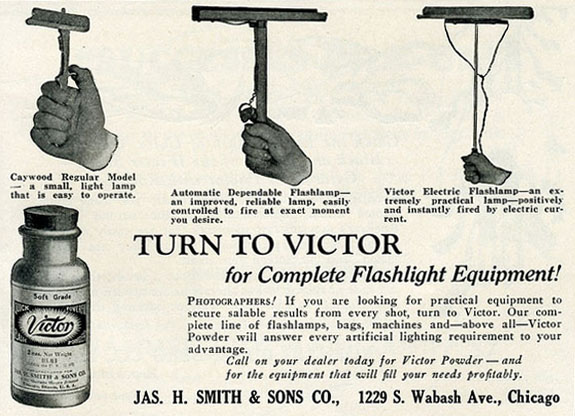
To illuminate a subject, a photographer would pour a quantity of this lethal grey powder into a ‘flash-tray’, a narrow trough-like metal channel about twelve inches long attached to a short pole and equipped with a sparking trigger mechanism.
The idea was for the photographer, or more usually, an assistant, to hold this device high above his head; and certainly as far away from his face as his outstretched arm would permit. At a pre-arranged signal, the photographer opened the shutter of the camera, or more likely removed a cap covering the lens, and the assistant would press the trigger to fire the flash powder. The result was a blinding flash of white light, but, sometimes, it was even more spectacular. Too much flash powder and the assistant sustained second degree burns and lost all his hair. At the very least he would be blinded for several minutes and his face blackened and ingrained by sooty aluminium particles that took days to pick out with a sewing needle.
Blast it!
Dougie’s desire to concoct his own flash powder was quite at odds with his chain smoking habits and, when the glowing ash from his cigarette dropped into his mixing bowl, detonations of quite staggering brilliance would result. They were the kind of explosions that we ‘felt’ rather than ‘heard’ next door in the main photographers’ darkroom. There were numerous emergencies at the Advertiser.
The walls of our communal darkroom next door would bulge momentarily and we would all look at each other in shock before rushing next door to find Dougie sitting dazed on the floorboards amidst a debris of broken bottles and shattered mixing bowls. Sheets of photographic paper, blown from their boxes by the blast, littered the floor, grey dust was suspended in the air and thick, black, acrid smoke billowed out along the corridor. After one particularly violent detonation we found Dougie lying on his back on his darkroom floor, blackened and singed but breathing. We really thought he had overdone it and were hugely relieved when he opened his eyes and squinted at us through his sooty spectacles.
“That’ll make the buggers blink,” he coughed.
READ THE NEXT EPOSIDE – Flash Powder and trilby hats
Philip Dunn’s 21st Century photography tuition now available online with ZOOM
